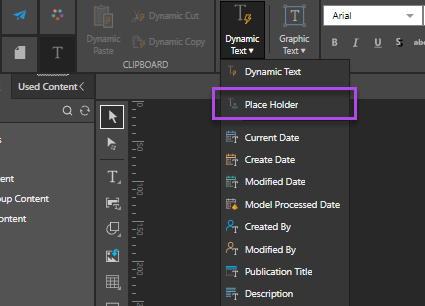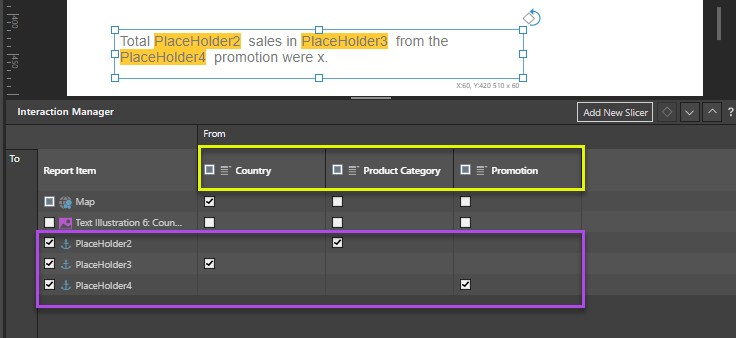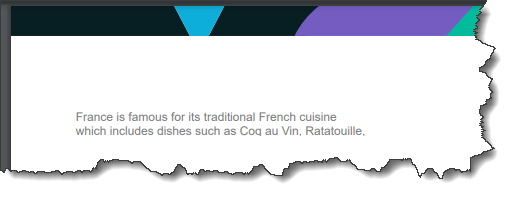Dynamic place holders give users the ability to configure slicer-driven dynamic text within Present and Publish. The text will change dynamically according to the slicer selection.
Add a Dynamic Place Holder
To configure a dynamic place holder:
- Add a textbox to the page and enter the required text.
- With the textbox selected, go to the text ribbon, open the Dynamic Text drop-down list and select Place Holder (purple highlight below).
- Use the Interaction Manager to configure the data interaction(s) between the slicer(s) and the text.
- You can also write a PQL expression to drive the place holder.
When the publication is rendered, the dynamic placeholders will change dynamically according to the slicer selections.

Interaction Manager
From the Interaction Manager, manage interactions and slicers for content items that are on the currently selected page. You can add, remove, and edit interactions, add and delete slicers, and view slicer settings.
Open the Interaction Manager to define interactions between the placeholders (purple highlight below) and the slicers (yellow highlight below). Each place holder can have a single interaction with one slicer.

Configure Dynamic Place Holder Expressions
Use the Dynamic Place Holder Editor to write PQL expressions to drive the place holder.
To open the Dynamic Place Holder editor, simply click on the placeholder in its textbox; the editor will open along the bottom of the interface. By default, the existing formula will be:
value()
To add a PQL function from the library to the script editor, simply double click on it. You will then need to inject values into the function.

PQL Functions
The Pyramid Query Language or PQL (pronounced 'Prequel') is a language built into Pyramid's PYRANA engine to allow users to construct queries that can run against the many SQL data stacks that Pyramid can query natively. PQL includes a vast array of operations and functions that allows users to query data and build analytical logic.
The Dynamic Place Holder Editor exposes Dynamic and Common functions. Dynamic functions are a set of specialized method that are designed to act on a given query 's result set. Common functions are a set of methods that are found in most programmatic and mathematical function libraries. These functions are used to perform logic on basic data without concern for data structures, context, or even source.
Here, the place holder will return True is the item selected from the slicer ends in "ries", or False if it doesn't:

In this example, the place holder text will be bold:

Using the AI-Driven LLM PQL Function
Use the LLM function (from the Common PQL functions) to generate dynamic text. This can be used to add additional information and background to your publication; it cannot tell you about your data set.
Pyramid's Generate AI integration enables you to use AI to generate scripts and images, dynamic text and infographics, calculations and lists, schedules, colors, and more. This allows you to generate a range of content, including complex code, by simply providing a text prompt.
Use the AI-driven LLM PQL function (from the Common PQL functions) to generate dynamic text. While this function cannot tell you about your data set, it can add additional information and background to your presentation.
You can also use your data to drive the results generated by your underlying LLM (such as OpenAI's ChatGPT) by creating interactions between visuals or slicers and the dynamic place holder where the PQL function is injected.
Warning: When using LLMs, your assets are generated using public domain algorithms. This can produce erroneous and inconsistent or random results. Use at your own risk.
In this example, an interaction was added from a Country slicer to the dynamic place holder.

The place holder is driven by the ChatGPT PQL function.

Note: ChatGPT is the alternative name for this common function. The main name for the function is now LLM.
When the publication is rendered, the place holder returns information about famous food in the given country.
